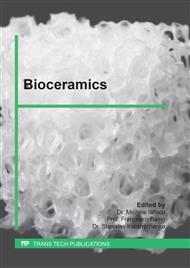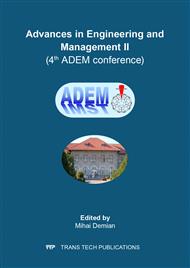[1]
A. Moshiri, A. Oryan, Role of tissue engineering in tendon reconstructive surgery and regenerative medicine: current concepts, approaches and concerns, Hard Tissue. 1 (2012) 1-11.
DOI: 10.13172/2050-2303-1-2-291
Google Scholar
[2]
H. Schaaf, S. Lendeckel, H.P. Howaldt, P. Streckbein, Donor site morbidity after bone harvesting from the anterior iliac crest, Oral Surg. Oral Med. Oral Pathol. Oral Radiol. 109 (2010) 52-58.
DOI: 10.1016/j.tripleo.2009.08.023
Google Scholar
[3]
A.Carlsen, A. Gorst-Rasmussen, T. Jensen, Donor site morbidity associated with autogenous bone harvesting from the ascending mandibular ramus, Implant Dent. 22 (2013) 503-506.
DOI: 10.1097/id.0b013e318296586c
Google Scholar
[4]
L.M. Qvick, C.A. Ritter, C.E. Mutty, B.J. Rohrbacher, C.M. Buyea and M.J. Anders, Donor site morbidity with reamer-irrigator-aspirator (RIA) use for autogenous bone graft harvesting in a single centre 204 case series, Injury. 44 (2013) 1263-1269.
DOI: 10.1016/j.injury.2013.06.008
Google Scholar
[5]
D. Bellucci, A. Sola, V. Cannillo, A Revised Replication Method for Bioceramic Scaffolds, Bioceram Dev Appl. 1(2011) 1-8.
DOI: 10.4303/bda/d110401
Google Scholar
[6]
K. Su-Gwan, K. Hak-Kyun, L. Sung-Chul, Combined implantation of particulate dentine, plaster of Paris, and a bone xenograft (Bio-Oss) for bone regeneration in rats, J. Craniomaxillofac. Surg. 29 (2001) 282-288.
DOI: 10.1054/jcms.2001.0236
Google Scholar
[7]
C.S. Ahmad, W.B. Guiney, C.J. Drinkwater, Evaluation of donor site intrinsic healing response in autologous osteochondral grafting of the knee, Arthroscopy. 18 (2002) 95-98.
DOI: 10.1053/jars.2002.25967
Google Scholar
[8]
G.M. Calori, E. Mazza, M. Colombo, C. Ripamonti, The use of bone-graft substitutes in large bone defects: any specific needs? Injury. 42 (2011) 56-63.
DOI: 10.1016/j.injury.2011.06.011
Google Scholar
[9]
R. Langer, J.P. Vacanti, Tissue engineering, Science. 260 (1993) 920-928.
Google Scholar
[10]
O. Gauthier, J.M. Bouler, E. Aguado, P. Pilet, G. Daculsi, Macroporous biphasic calcium phosphate ceramics: influence of macropore diameter and macroporosity percentage on bone ingrowth, Biomaterials. 19 (1998) 133-139.
DOI: 10.1016/s0142-9612(97)00180-4
Google Scholar
[11]
P. Kasten, I. Beyen, P. Niemeyer, R. Luginbühl, M. Bohner, W. Richter, Porosity and pore size of beta-tricalcium phosphate scaffold can influence protein production and osteogenic differentiation of human mesenchymal stem cells: an in vitro and in vivo study, Acta Biomater. 4 (2008).
DOI: 10.1016/j.actbio.2008.05.017
Google Scholar
[12]
M.H. Mankani, S.A. Kuznetsov, B. Fowler, A. Kingman, P.G. Robey, In vivo bone formation by human bone marrow stromal cells: effect of carrier particle size and shape, Biotechnol. Bioeng. 72 (2001) 96-107.
DOI: 10.1002/1097-0290(20010105)72:1<96::aid-bit13>3.0.co;2-a
Google Scholar
[13]
M.C. von Doernberg, B. von Rechenberg, M. Bohner, S. Grünenfelder, G.H. van Lenthe, R. Müller, B. Gasser, R. Mathys, G. Baroud, J. Auer, In vivo behavior of calcium phosphate scaffolds with four different pore sizes, Biomaterials 27 (2006).
DOI: 10.1016/j.biomaterials.2006.05.051
Google Scholar
[14]
A.R. Amini, C.T. Laurencin, S.P. Nukavarapu, Bone tissue engineering: recent advances and challenges. Crit. Rev. Biomed. Eng. 4 (2012) 363-408.
DOI: 10.1615/critrevbiomedeng.v40.i5.10
Google Scholar
[15]
, 16] M. Bonher, L. Galea, N. Doebelin, Calcium phosphate bone graft substitutes: failures and hopes. J. Eur. Ceram. Soc. 32 (2012).
DOI: 10.1016/j.jeurceramsoc.2012.02.028
Google Scholar
[17]
W. Suchanek , M. Yoshimura, Processing and properties of hydroxyapatite-based biomaterials for use as hard tissue replacement implants, J. Mater. Res. 13 (1998) 94-117.
DOI: 10.1557/jmr.1998.0015
Google Scholar
[18]
R.M. Pilliar, M.J. Filiaggi, J.D. Wells, M.D. Grynpas, R.A. Kandel, Porous calcium polyphosphate scaffolds for bone substitute applications -- in vitro characterization, Biomaterials 22 (2001) 963-972.
DOI: 10.1016/s0142-9612(00)00261-1
Google Scholar
[19]
G. Daculsi, N. Passuti, Effect of the macroporosity for osseous substitution of calcium phosphate ceramics, Biomaterials 11 (1990) 86-87.
Google Scholar
[20]
S.V. Dorozhkin, Calcium Orthophosphate-Containing Biocomposites and Hybrid Biomaterials for Biomedical Applications,J. Funct. Biomater. 6 (2015) 708-832.
DOI: 10.3390/jfb6030708
Google Scholar
[21]
R.A. Ayers, S.J. Simske, C.R. Nunes, L.M. Wolford, Long-term bone ingrowth and residual microhardness of porous block hydroxyapatite implants in humans, J Oral Maxillofac Surg. 56 (1998) 1297-1301.
DOI: 10.1016/s0278-2391(98)90613-9
Google Scholar
[22]
I. G. Bucse, C.Ristoscu, B. A. Olei, Structural analysis of PM hydroxyapatite-based biocomposites elaborated by two-step sintering, J Optoelectron Adv M. 17 (2015) 1050-1054.
Google Scholar
[23]
B. Matijasevic, S. Fiechter, I. Zizak, O. Gorke, N. Wanderka, P. Bischoff, J. Banhart, Decomposition behaviour of as-received and oxidized TiH2 powder, Powder Metallurgy World Congress, (2004) 149.
Google Scholar
[24]
C. Teisanu, G. Sima, Solid-state foaming in two step sintering to produce HAp-based biocomposites for bone grafting, in: A. Rotaru (Ed.), Advanced Engineering Materials. Recent Developments for Medical, Technological and Industrial Applications, Academica Greifswald Publishing House, Greifswald, 2016, submitted to editor.
Google Scholar
[25]
J. W. Lee, B. Hawkins, X. Li, D.M. Day, Biochar fertilizer for soil amendment and carbon sequestration, in: J.W. Lee (Ed.), Advanced Biofuels and Bioproducts, vol.1, Springer Science + Business Media, New York, 2013, pp.57-68.
DOI: 10.1007/978-1-4614-3348-4_6
Google Scholar
[26]
Information on http://www.icodassociates.com/docs/blowing_agents.pdf.
Google Scholar
[27]
A. Ibrahim, F. Zhang, E. Otterstein, E. Burkel, Processing of porous Ti and Ti5Mn foams by spark plasma sintering, Mater Des 32(2011) 146-153.
DOI: 10.1016/j.matdes.2010.06.019
Google Scholar
[28]
R.E. Holmes, R.W. Wardrop, L.M. Wolford, Hydroxylapatite as a bone graft substitute in orthognathic surgery: histologic and histometric findings, J. Oral Maxillofac. Surg. 46 (1998) 661–671.
DOI: 10.1016/0278-2391(88)90109-7
Google Scholar
[29]
E. Cunningham, N. Dunne, G. Walker, C. Maggs, R. Wilcox, F. Buchanan, Hydroxyapatite bone substitutes developed via replication of natural marine sponges, J Mater Sci Mater Med 21 (2010) 2255–2261.
DOI: 10.1007/s10856-009-3961-4
Google Scholar
[30]
C. Marinescu, A. Sofronia, E. M. Anghel, R. Baies, D. Constantin, A.-M. Seciu, O. Gingu, S. Tanasescu: submitted to Arabian Journal of Chemistry (2017).
DOI: 10.1016/j.arabjc.2017.01.019
Google Scholar
[31]
S. Scaglione, P. Giannoni, P. Bianchini, M. Sandri, R. Marotta, G. Firpo, U. Valbusa, A. Tampieri, A. Diaspro, P. Bianco, R. Quarto, Order versus disorder: in vivo bone formation within osteoconductive scaffolds, Scientific Reports. 274 (2012).
DOI: 10.1038/srep00274
Google Scholar
[32]
M. Nicoara, A. Raduta, C. Locovei, C. Opris, D. Sosdean, R. Vasiu, F. Gnandt, D. Lungu Daian, Optimizing the Parameters of Reactive Sintering for In-situ Fabrication of Al-Al2O3 Composites, Solid State Phenomena, 216 (214) 255-260.
DOI: 10.4028/www.scientific.net/ssp.216.255
Google Scholar
[33]
A. Wennerberg, A. Ektesabi, T. Albrektsson, C. Johansson, B. Andersson, A 1-year follow-up of implants of differing surface roughness placed in rabbit bone, Int J Oral Maxillofac Implants, 12 (1997) 486-494.
Google Scholar
[34]
H.R. Ramay, M. Zhang, Preparation of porous hydroxyapatite scaffolds by combination of the gel-casting and polymer sponge methods, Biomaterials 24 (2003) 3293–3302.
DOI: 10.1016/s0142-9612(03)00171-6
Google Scholar
[35]
J. I. Gonzalez Ocampo, D. M. Escobar Sierra, C. P. Ossa Orozco, Porous bodies of hydroxyapatite produced by a combination of the gel-casting and polymer sponge methods, J Adv Res. 7 (2016) 297-304.
DOI: 10.1016/j.jare.2015.06.006
Google Scholar
[36]
J. Liu, X. Miao, Porous alumina ceramics prepared by slurry infiltration of expanded polystyrene beads, J Mater Sci. 40 (2005) 6145–6150.
DOI: 10.1007/s10853-005-3165-3
Google Scholar



